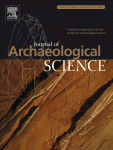| New Volume/Issue is now available on ScienceDirect |
| | Original Research Articles | |
| | 3. | The use of summed radiocarbon probability distributions in archaeology: a review of methods Original Research Article
Pages 578-589
Alan N. Williams
Highlights► Methodological issues with the use of sum probability plots are explored. ► The paper uses a dataset of 299614C dates from >800 sites across Australia. ► Analysis shows sample size, calibration and taphonomic loss all have an effect. ► Protocols for future production of sum probability plots are proposed. ► Comparison of plots and other archaeological indices show good correlation.
| |
| | 4. | Understanding faunal contexts of a complexTell: Tel Dor, Israel, as a case study Original Research Article
Pages 590-601
Lidar Sapir-Hen, Guy Bar-Oz, Ilan Sharon, Ayelet Gilboa, Tamar Dayan
Highlights► We studied site formation processes and their reflection in the faunal remains of a complextellsite. ► Bones can reflect primary activities that took place where they were found. ► Different types of contexts can be differentiated from one another using faunal remains. ► Spatial analysis of faunal remains helps elucidate site formation processes. ► Lumping archaeozoological data into a single ‘assemblage’ causes major loss of information.
| |
| | 6. | Energy-Dispersive X-Ray Fluorescence analysis of Haleakalā basalt adze quarry materials, Maui, Hawai‘i Original Research Article
Pages 615-623
Melanie A. Mintmier, Peter R. Mills, Steven P. Lundblad
Highlights► We collected lithic materials from a major Hawaiian basalt adze quarry. ► We examined these lithic materials using Energy-Dispersive X-Ray Fluorescence. ► Analysis of Sr and Zr appears sufficient for distinguishing major basalt sources. ► EDXRF appears effective for distinguishing material from major basalt sources.
| |
| | 7. | Calcareous fossil inclusions and rock-source of Maya lime plaster from the Temple of the Inscriptions, Palenque, Mexico Original Research Article
Pages 624-639
Francisco Riquelme, Jesús Alvarado-Ortega, Martha Cuevas-García, José Luis Ruvalcaba-Sil, Carlos Linares-López
Highlights► Fossiliferous deposits nearby Palenque described in an archeological context. ► Calcareous fossil remains recovered from plaster and mortar from the Temple of the Inscriptions. ► Lime plaster from the Temple of the Inscriptions associated with dolomitic limestone source. ► Fossil material linked to the fossil-bearing rocks selected by the Maya of Palenque. ► Fossiliferous rocks used as a raw material agree with the geological setting of the Palenque area.
| |
| | 9. | Taphonomy and sample size estimation in paleoethnobotany Original Research Article
Pages 648-655
Gyoung-Ah Lee
Highlights► Evaluate taphonomic pathways of plants from archaeological deposits. ► Clarify how far cultural implication can be drawn from the retrieved plant remains. ► Design a statistical measure that estimates comparable sample sizes of plant data. ► Obtain the quantitative compatibility through standardizing sample sizes.
| |
| | 11. | A PXRF-based chemostratigraphy and provenience system for the Cooper’s Ferry site, Idaho Original Research Article
Pages 663-671
Loren G. Davis, Shane J. Macfarlan, Celeste N. Henrickson
Highlights► Establishes a chemostratigraphy, relating objects to a lithostratigraphic sequence. ► Uses x-ray fluorescence readings subjected to multiple discriminant function analysis. ► Method can discriminate rodent burrows from intact sediments. ► Enables independent evaluation of association between artifacts and intact sediments.
| |
| | 12. | Colouring materials of pre-Columbian codices: non-invasivein situspectroscopic analysis of the Codex Cospi Original Research Article
Pages 672-679
C. Miliani, D. Domenici, C. Clementi, F. Presciutti, F. Rosi, D. Buti, A. Romani, L. Laurencich Minelli, A. Sgamellotti
Highlights► A non-invasive study of colours was carried out on the pre-Columbian Codex Cospi. ► Cochineal, carbon black, Maya blue and orpiment were found on the reverse side. ► A large variety of organic colourants were found on the obverse side. ► Analytical data were compared with early colonial Mexican historical fonts.
| |
| | 13. | Raw material economy in Salento (Apulia, Italy): new perspectives on Neanderthal mobility patterns Original Research Article
Pages 680-689
Enza Elena Spinapolice
Highlights► The aim of the paper is to test raw material provisioning during the Mousterian in the light of Neanderthal behavior. ► The case study is the Salento Region, Apulia, Italy. ► We studied archaeological materials from selected sites and systematic surveys. ► We found local provisioning of “bad quality” raw materials. ► We found long distance provisioning of good quality raw materials. ► We concluded that the provisioning could be considered “modern”.
| |
| | 15. | Object-based landform delineation and classification from DEMs for archaeological predictive mapping Original Research Article
Pages 698-703
Philip Verhagen, Lucian Drăguţ
Highlights► Archaeologists currently rely on visual interpretation of DEMs to analyse landform. ► Object-based image analysis (OBIA) is a new tool to extract landform from DEMs. ► OBIA was tested to see whether it could match visual interpretation. ► The results show that OBIA produces good results, is quicker and more objective. ► A contextual framework for classification of landform still needs to be developed.
| |
| | 17. | Icelandic volcanic ash from the Late-glacial open-air archaeological site of Ahrenshöft LA 58 D, North Germany Original Research Article
Pages 708-716
R.A. Housley, C.S. Lane, V.L. Cullen, M.-J. Weber, F. Riede, C.S. Gamble, F. Brock
Highlights► Analyse tephrostratigraphy of a Late-glacial open-air archaeological site in north Germany. ► Site taphonomy revealed as crucial factor in cryptotephra preservation. ► Geochemistry indicates one Icelandic rhyolitic eruption from Katla. ► Three potential correlates identified – Vedde Ash or AF555 tephra or Suduroy tephra.
| |
| | 18. | First comprehensive peat depositional records for tin, lead and copper associated with the antiquity of Europe's largest cassiterite deposits Original Research Article
Pages 717-727
Andrew A. Meharg, Kevin J. Edwards, J. Edward Schofield, Andrea Raab, Joerg Feldmann, Annette Moran, Charlotte L. Bryant, Barry Thornton, Julian J.C. Dawson
Highlights► Investigations of peat core profiles in SW Britain enable us to address the use of tin in antiquity. ► The first prolonged elevation of tin influx to a peat profile corresponds to Roman occupation. ► There was a collapse in production during the early Anglo-Saxon period. ► There was a re-expansion in tin production during the later Anglo-Saxon period. ► British tin appears to be the source of the used in wider European trade for this latter period.
| |
| | 19. | Non-destructive PXRF analysis of museum-curated obsidian from the Near East Original Research Article
Pages 728-736
Nicola Forster, Peter Grave
Highlights► Characterisation of museum-curated obsidian from the Near East using non-destructive PXRF. ► Non-destructive PXRF is sufficiently reliable for comparison with legacy datasets. ► Multivariate analysis provenancing artefacts using geological and legacy datasets. ► Göllü dağ, Nenezi dağ, Bingöl and region around Lake Van major obsidian sources during Chalcolithic. ► Variation in assemblages suggests different obsidian exchange networks were in operation.
| |

Núcleo de Arqueologia e Paleoecologia Laboratório G22 FCHS - Departamento de História, Arqueologia e Património Universidade do Algarve Campus de Gambelas 8005-139 Faro, PORTUGAL Mail: nap.ualg@gmail.comUrl: http://nap-ualg.blogspot.com
|




